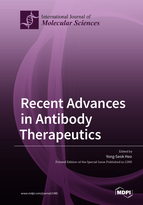Recent Advances in Antibody Therapeutics
A special issue of International Journal of Molecular Sciences (ISSN 1422-0067). This special issue belongs to the section "Molecular Pharmacology".
Deadline for manuscript submissions: closed (31 March 2021) | Viewed by 63660
Special Issue Editor
Interests: therapeutic antibody; cancer immunotherapy; antibody engineering; structure and mechanism of antibody drugs; protein structure
Special Issues, Collections and Topics in MDPI journals
Special Issue Information
Dear Colleagues,
Antibody-based therapeutics have achieved unprecedented success for the treatment of various diseases including cancer, immune disorders, and infectious diseases. The recent success in immune checkpoint inhibitors and chimeric antigen receptor T cells (CAR-T) has provided a major breakthrough in cancer immunotherapy. Therapeutic antibodies are also expected to play a role in the prevention and treatment of the coronavirus pandemic (COVID-19).
These achievements in the field of antibody therapeutics is related to major advances in antibody engineering for the generation of safe, specific, high-affinity, and non-immunogenic antibodies during the last few decades. In addition, currently, a major area of antibody research and development includes the discovery of novel targets and novel antibodies, gradual improvements in the characteristics of the existing antibodies, combining antibodies such as bispecific antibodies, antibody–drug conjugates (ADC), CAR-T cells, bispecific T-cell engagers (BiTE), and developing novel antibody-based scaffolds with superior properties to those already in use.
This Special Issue will cover all aspects of the role and mechanism of antibody-based therapeutics in disease treatment, recent advances in antibody engineering, and noteworthy antibody-based products under investigation for treating various diseases. Original papers and review articles are welcomed.
Prof. Dr. Yong-Seok Heo
Guest Editor
Manuscript Submission Information
Manuscripts should be submitted online at www.mdpi.com by registering and logging in to this website. Once you are registered, click here to go to the submission form. Manuscripts can be submitted until the deadline. All submissions that pass pre-check are peer-reviewed. Accepted papers will be published continuously in the journal (as soon as accepted) and will be listed together on the special issue website. Research articles, review articles as well as short communications are invited. For planned papers, a title and short abstract (about 100 words) can be sent to the Editorial Office for announcement on this website.
Submitted manuscripts should not have been published previously, nor be under consideration for publication elsewhere (except conference proceedings papers). All manuscripts are thoroughly refereed through a single-blind peer-review process. A guide for authors and other relevant information for submission of manuscripts is available on the Instructions for Authors page. International Journal of Molecular Sciences is an international peer-reviewed open access semimonthly journal published by MDPI.
Please visit the Instructions for Authors page before submitting a manuscript. There is an Article Processing Charge (APC) for publication in this open access journal. For details about the APC please see here. Submitted papers should be well formatted and use good English. Authors may use MDPI's English editing service prior to publication or during author revisions.
Keywords
- therapeutic antibody
- antibody–drug conjugate (ADC)
- chimeric antigen receptor T cell (CAR-T)
- bispecific antibody
- bispecific T-cell engager (BiTE)
- nanobody
- immunotherapy
- cancer
- autoimmune disease
- infectious disease
- COVID-19
- biosimilar
- antibody engineering
- structure and mechanism of antibody drugs







